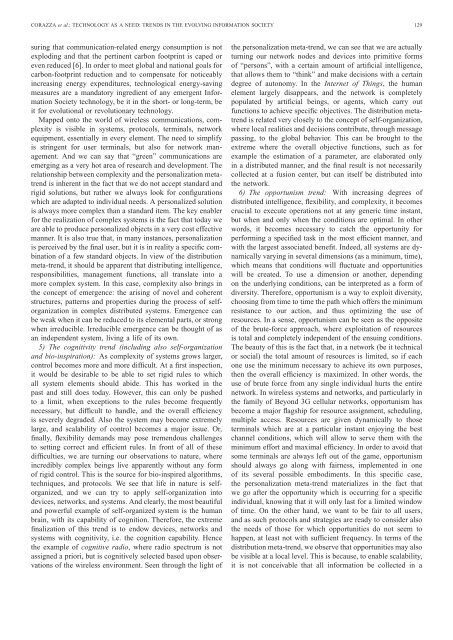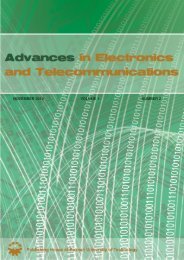channel - Advances in Electronics and Telecommunications
channel - Advances in Electronics and Telecommunications
channel - Advances in Electronics and Telecommunications
Create successful ePaper yourself
Turn your PDF publications into a flip-book with our unique Google optimized e-Paper software.
CORAZZA et al.: TECHNOLOGY AS A NEED: TRENDS IN THE EVOLVING INFORMATION SOCIETY 129<br />
sur<strong>in</strong>g that communication-related energy consumption is not<br />
explod<strong>in</strong>g <strong>and</strong> that the pert<strong>in</strong>ent carbon footpr<strong>in</strong>t is caped or<br />
even reduced [6]. In order to meet global <strong>and</strong> national goals for<br />
carbon-footpr<strong>in</strong>t reduction <strong>and</strong> to compensate for noticeably<br />
<strong>in</strong>creas<strong>in</strong>g energy expenditures, technological energy-sav<strong>in</strong>g<br />
measures are a m<strong>and</strong>atory <strong>in</strong>gredient of any emergent Information<br />
Society technology, be it <strong>in</strong> the short- or long-term, be<br />
it for evolutional or revolutionary technology.<br />
Mapped onto the world of wireless communications, complexity<br />
is visible <strong>in</strong> systems, protocols, term<strong>in</strong>als, network<br />
equipment, essentially <strong>in</strong> every element. The need to simplify<br />
is str<strong>in</strong>gent for user term<strong>in</strong>als, but also for network management.<br />
And we can say that “green” communications are<br />
emerg<strong>in</strong>g as a very hot area of research <strong>and</strong> development. The<br />
relationship between complexity <strong>and</strong> the personalization metatrend<br />
is <strong>in</strong>herent <strong>in</strong> the fact that we do not accept st<strong>and</strong>ard <strong>and</strong><br />
rigid solutions, but rather we always look for configurations<br />
which are adapted to <strong>in</strong>dividual needs. A personalized solution<br />
is always more complex than a st<strong>and</strong>ard item. The key enabler<br />
for the realization of complex systems is the fact that today we<br />
are able to produce personalized objects <strong>in</strong> a very cost effective<br />
manner. It is also true that, <strong>in</strong> many <strong>in</strong>stances, personalization<br />
is perceived by the f<strong>in</strong>al user, but it is <strong>in</strong> reality a specific comb<strong>in</strong>ation<br />
of a few st<strong>and</strong>ard objects. In view of the distribution<br />
meta-trend, it should be apparent that distribut<strong>in</strong>g <strong>in</strong>telligence,<br />
responsibilities, management functions, all translate <strong>in</strong>to a<br />
more complex system. In this case, complexity also br<strong>in</strong>gs <strong>in</strong><br />
the concept of emergence: the aris<strong>in</strong>g of novel <strong>and</strong> coherent<br />
structures, patterns <strong>and</strong> properties dur<strong>in</strong>g the process of selforganization<br />
<strong>in</strong> complex distributed systems. Emergence can<br />
be weak when it can be reduced to its elemental parts, or strong<br />
when irreducible. Irreducible emergence can be thought of as<br />
an <strong>in</strong>dependent system, liv<strong>in</strong>g a life of its own.<br />
5) The cognitivity trend (<strong>in</strong>clud<strong>in</strong>g also self-organization<br />
<strong>and</strong> bio-<strong>in</strong>spiration): As complexity of systems grows larger,<br />
control becomes more <strong>and</strong> more difficult. At a first <strong>in</strong>spection,<br />
it would be desirable to be able to set rigid rules to which<br />
all system elements should abide. This has worked <strong>in</strong> the<br />
past <strong>and</strong> still does today. However, this can only be pushed<br />
to a limit, when exceptions to the rules become frequently<br />
necessary, but difficult to h<strong>and</strong>le, <strong>and</strong> the overall efficiency<br />
is severely degraded. Also the system may become extremely<br />
large, <strong>and</strong> scalability of control becomes a major issue. Or,<br />
f<strong>in</strong>ally, flexibility dem<strong>and</strong>s may pose tremendous challenges<br />
to sett<strong>in</strong>g correct <strong>and</strong> efficient rules. In front of all of these<br />
difficulties, we are turn<strong>in</strong>g our observations to nature, where<br />
<strong>in</strong>credibly complex be<strong>in</strong>gs live apparently without any form<br />
of rigid control. This is the source for bio-<strong>in</strong>spired algorithms,<br />
techniques, <strong>and</strong> protocols. We see that life <strong>in</strong> nature is selforganized,<br />
<strong>and</strong> we can try to apply self-organization <strong>in</strong>to<br />
devices, networks, <strong>and</strong> systems. And clearly, the most beautiful<br />
<strong>and</strong> powerful example of self-organized system is the human<br />
bra<strong>in</strong>, with its capability of cognition. Therefore, the extreme<br />
f<strong>in</strong>alization of this trend is to endow devices, networks <strong>and</strong><br />
systems with cognitivity, i.e. the cognition capability. Hence<br />
the example of cognitive radio, where radio spectrum is not<br />
assigned a priori, but is cognitively selected based upon observations<br />
of the wireless environment. Seen through the light of<br />
the personalization meta-trend, we can see that we are actually<br />
turn<strong>in</strong>g our network nodes <strong>and</strong> devices <strong>in</strong>to primitive forms<br />
of “persons”, with a certa<strong>in</strong> amount of artificial <strong>in</strong>telligence,<br />
that allows them to “th<strong>in</strong>k” <strong>and</strong> make decisions with a certa<strong>in</strong><br />
degree of autonomy. In the Internet of Th<strong>in</strong>gs, the human<br />
element largely disappears, <strong>and</strong> the network is completely<br />
populated by artificial be<strong>in</strong>gs, or agents, which carry out<br />
functions to achieve specific objectives. The distribution metatrend<br />
is related very closely to the concept of self-organization,<br />
where local realities <strong>and</strong> decisions contribute, through message<br />
pass<strong>in</strong>g, to the global behavior. This can be brought to the<br />
extreme where the overall objective functions, such as for<br />
example the estimation of a parameter, are elaborated only<br />
<strong>in</strong> a distributed manner, <strong>and</strong> the f<strong>in</strong>al result is not necessarily<br />
collected at a fusion center, but can itself be distributed <strong>in</strong>to<br />
the network.<br />
6) The opportunism trend: With <strong>in</strong>creas<strong>in</strong>g degrees of<br />
distributed <strong>in</strong>telligence, flexibility, <strong>and</strong> complexity, it becomes<br />
crucial to execute operations not at any generic time <strong>in</strong>stant,<br />
but when <strong>and</strong> only when the conditions are optimal. In other<br />
words, it becomes necessary to catch the opportunity for<br />
perform<strong>in</strong>g a specified task <strong>in</strong> the most efficient manner, <strong>and</strong><br />
with the largest associated benefit. Indeed, all systems are dynamically<br />
vary<strong>in</strong>g <strong>in</strong> several dimensions (as a m<strong>in</strong>imum, time),<br />
which means that conditions will fluctuate <strong>and</strong> opportunities<br />
will be created. To use a dimension or another, depend<strong>in</strong>g<br />
on the underly<strong>in</strong>g conditions, can be <strong>in</strong>terpreted as a form of<br />
diversity. Therefore, opportunism is a way to exploit diversity,<br />
choos<strong>in</strong>g from time to time the path which offers the m<strong>in</strong>imum<br />
resistance to our action, <strong>and</strong> thus optimiz<strong>in</strong>g the use of<br />
resources. In a sense, opportunism can be seen as the opposite<br />
of the brute-force approach, where exploitation of resources<br />
is total <strong>and</strong> completely <strong>in</strong>dependent of the ensu<strong>in</strong>g conditions.<br />
The beauty of this is the fact that, <strong>in</strong> a network (be it technical<br />
or social) the total amount of resources is limited, so if each<br />
one use the m<strong>in</strong>imum necessary to achieve its own purposes,<br />
then the overall efficiency is maximized. In other words, the<br />
use of brute force from any s<strong>in</strong>gle <strong>in</strong>dividual hurts the entire<br />
network. In wireless systems <strong>and</strong> networks, <strong>and</strong> particularly <strong>in</strong><br />
the family of Beyond 3G cellular networks, opportunism has<br />
become a major flagship for resource assignment, schedul<strong>in</strong>g,<br />
multiple access. Resources are given dynamically to those<br />
term<strong>in</strong>als which are at a particular <strong>in</strong>stant enjoy<strong>in</strong>g the best<br />
<strong>channel</strong> conditions, which will allow to serve them with the<br />
m<strong>in</strong>imum effort <strong>and</strong> maximal efficiency. In order to avoid that<br />
some term<strong>in</strong>als are always left out of the game, opportunism<br />
should always go along with fairness, implemented <strong>in</strong> one<br />
of its several possible embodiments. In this specific case,<br />
the personalization meta-trend materializes <strong>in</strong> the fact that<br />
we go after the opportunity which is occurr<strong>in</strong>g for a specific<br />
<strong>in</strong>dividual, know<strong>in</strong>g that it will only last for a limited w<strong>in</strong>dow<br />
of time. On the other h<strong>and</strong>, we want to be fair to all users,<br />
<strong>and</strong> as such protocols <strong>and</strong> strategies are ready to consider also<br />
the needs of those for which opportunities do not seem to<br />
happen, at least not with sufficient frequency. In terms of the<br />
distribution meta-trend, we observe that opportunities may also<br />
be visible at a local level. This is because, to enable scalability,<br />
it is not conceivable that all <strong>in</strong>formation be collected <strong>in</strong> a







